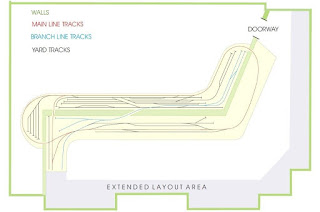“Have
you seen Dave Gunn’s layout?” That’s what Jason Shron asked me earlier this
month.
“His
layout is really gorgeous,” he added. “I’m sure he would provide stuff for your
blog.”
On
Jason’s recommendation, I contacted Dave. He was right; Dave does have a
gorgeous HO scale layout, as you can see in the photos below.
Enjoy
the visit!
What is the era? Why did you choose
that one?
I
model the 1950s, the transition period. I chose it because I like to be able to
run both steam and diesel. Plus, it’s the period I grew up in.
What is the locale or region? Why did
you choose that one?
The
layout is based very loosely on the 110-mile run between Nappanee and Ottawa,
running through Smiths Falls. It connects Ottawa to the Montreal-Toronto
Corridor. I chose it because I grew up in Ontario.
What railway (or railways) do you model?
Why did you choose that one?
The
CNR of course! I have always loved the green, gold and black colour scheme.
I
also model my private short line the DN&P. It stands for the Dominion,
National and Pacific, or the Dave, Nick and Pam. (Pam is my wife, and
Nick is our son.)
What is the size of the layout?
The
basement room is 40-feet square, which also includes the sitting area and
workshop spaces. The layout covers approximately half the space. I am about
halfway around the room, so far.
What is the length of the
mainline?
It’s
approximately 80 feet long. There are five different places for the tracks
to disappear through the walls.
What kind of track do you use?
I
use code 83 Peco track, with all track glued in place—not a single track pin
has been used. Main line tracks are laid on cork road bed, and the sidings
directly on base boards.
How do you operate the layout?
I
have full operating sessions available with wheel reports, switch lists and
schedules drawn out on graph paper showing all trains in a 24 hour period of
operation and detailing all passing locations and stopping times, etc. Every
car has a purpose and destination.
What is your control system?
I
use Easy DCC wireless from Texas. It works very well. I have two fixed
controllers and two wireless controllers, as well as mobile phone connections for
extra controllers when required.
What scenery methods did you use?
I
use my own mixtures of scenic materials, including real dirt and soot that came
from the age of steam. For the rock faces, I used real rock from our local cliff
face.
For
the clouds, I used paper cut-outs, then sprayed on the clouds with aerosol paint.
It was easy to do.
What kind of locomotives do you run?
I
run some brass, lots of Rapido, and the usual collection of Athearn and others
gathered over the years.
What kind of industries are there?
The
layout is virtually all industrial complexes built from photographs or magazine
articles of real industries. A wide range of industries are in use, including
furniture factories, a large brewery, and other rail-served facilities.
There
are approximately 30 industries and 15 railway facilities, from freight sheds
to engine service facilities etc.
How did you build the structures?
The
structures on the layout are 99% scratchbuilt. A good percentage of rolling
stock is either scratchbuilt or from wood craftsman kits.
The
station is a replica of Stratford, Ontario station, fully scratchbuilt from
archival and recent photos. The platform is made from real cement mixed with
white wood glue and shuttered just like in real life. It also contains
wire rebar inside.
When did you start the layout? Did you
build it alone?
I
started it in 2006. The bulk of it is of my work. However, I do have a young
friend who helps from time to time. The brewery is a joint effort.
Any special or unique features of the layout?
The
electronics for the layout are all installed on pullout shelving, so all
maintenance work is carried out from above. No crawling under the
benchwork to do repairs! I use a lot of relays for lighting, frog
switching and signalling.
All
the wiring is numbered and fully recorded and I have well over 2,000 connections
so far. The facia panels are all easily removed and are
self-supporting.
They carry the track plan replica in various colours and
use small push to make buttons to operate the switch machines and reverse
polarity switching where necessary.
All
the switches have bi-colour LEDs to identify route selection. A full
double bus bar system is used, looping between each pullout shelf giving very
small volt drop throughout.
How long have you been a model
railroader?
I
had a Lionel train as a child and enjoyed building models right through my life.
I started properly in 1983 when I lived in Great Britain. I joined the NMRA
British region and became the first Master Model Railroader of that region in
July, 1995 (#240).
What attracted you to the hobby?
My
love of trains and the pleasure of building things. I am a retired chartered
marine engineer, and love all things mechanical.
 |
| Dave at his workbench. |
What do you enjoy most about the hobby?
Every
aspect of the hobby is so rewarding. The variety is endless, together with the
tremendous friendships built up over the years in this wonderful hobby.















Beautiful layout. Very much a credit to the builder!
ReplyDeleteThe only thing that surpasses Dave's modelling is the hospitality shown by Dave and Pam when I visited their home. Not enough good things can be said about them.
ReplyDelete